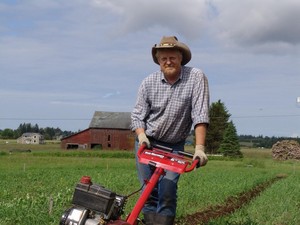11 Nov Wed 2009
The Magnitude of the Problem
Most people don't really grasp the magnitude of the peak oil problem as it relates to agriculture. Ever since the 1950's, there have been plenty of adverts extolling all the things that are made with petroleum products - from nylons to Nintendos. In the last few years, many people have started connecting the ubiquity of petroleum in our daily life to the food we eat. Without petroleum, there is no industrial agriculture and our ability to feed 6.8 billion people is compromised. Even now, we cannot feed everyone. The Green Revolution was heavily dependent on cheap fossil fuels; the increased levels of pesticides, artificial fertilizers, and research and development on high-yielding grains were all dependent on increasing use of cheap petroleum and its byproducts. Now, the increased population fostered by the Green Revolution has amped up the problem by several levels in India, Mexico and Asia. Yet the world supply of petroleum is decreasing and the price of a barrel of oil is steadily increasing. There are short-term price reductions, of course, but the overall price momentum continues to go up. These are all trends we can read about every day, but the sheer volume of info and the inability to put the problem in a local framework predisposes ordinary humans to just dismiss it. Here is a simple way to put the problem in perspective.
This year, I have produced enough calories on 1.5 acres to provide food for 3.54 people. This is based on 3.23 million calories produced from 77 crops and a calorie need of 2500 calories per person over 365 days (3,230,725 ÷ 365 ÷ 2500 = 3.54). To produce this food, I used 1.06 million calories (3000 hours of my labor at 125 calories per hour + 22.25 gallons of tiller gasoline at 31,000 calories per gallon = 1,064,750 calories). This gives me an efficiency ratio of 3.03 (3.23 million calories output ÷ 1.06 million calories input = 3.03). Now, these are interesting numbers, but how do they compare to the energy usage of a normal American driving 12,500 miles in a year with their car/truck at 25 miles per gallon? We can easily calculate this as 500 gallons of gas used per year and at 31,000 calories per gallon, the average American uses 15.5 million calories of gasoline - just to drive around. This means that the average driver uses over 15 times as much energy in their personal transportation use as I do for growing food to feed 3.5 people.
Obviously, the magnitude of the peak oil problem has more to do with personal transportation than with agriculture use. In point of fact, as we wind down our energy usage, it may become public policy to shift more of available fossil fuels to farmers to continue to feed people, while simultaneously restricting personal automobile use. This would certainly benefit everyone and would also keep industrial agriculture going for several more years. So why develop a sustainable model right now, when it would obviously be to my advantage to grow food through use of tractors on larger acreage? There are several reasons to abstain from the current industrial model.
1) I don't have access to enough land to grow food at the level of industrial agriculture.
2) I don't have enough capital to buy equipment, seed, fertilizer, etc at the industrial level. Nor do I have access to capital.
3) Industrial farming does not provide the same high-quality food I grow now, even from corporate organic farms. As any of you who have purchased so-called "organic" produce at the supermarket and compared it to my produce, my stuff wins hands down.
4) I am getting older and spending 14 hours on a tractor at a time does not sit well with my body.
5) The industrial ag game is rigged against family farmers - just ask any farmer in your own neighborhood.
6) Business plans are based on the future and the future is extremely dicey. Getting involved in a 5-year expansion based on current markets is just foolish.
A better model for solving current agriculture problems is to forget about being a "farmer." The real problem is growing food that is good to eat. Once you start thinking in this manner, a lot of alternatives are available but the main paradigm shift is to think about bridging the gap, or "transitioning" between the modern industrial agriculture model and the postmodern human-scale food production model. So what we need now are ways to grow food that meets our needs now, while simultaneously working towards a sustainable future. That's what I am doing. Even though I work with it every day, the magnitude of the problem is still a mind-blower.


Brilliant analysis of common sense.
Thanks Walter!